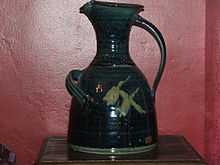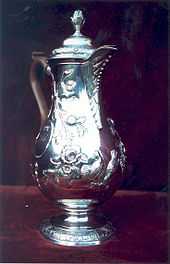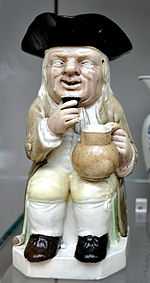Jug


A jug is a type of container commonly used to hold liquid. It has an opening, often narrow, from which to pour or drink, and often has a handle. Most jugs throughout history have been made of ceramic, glass or plastic. Some Native American and other tribes created liquid holding vessels by making woven baskets lined with an asphaltum sealer.
In American English usage, a jug is a large container with a narrow mouth and handle for liquids, and may be used to describe thin plastic sealed shop packaging for milk and other liquids. In all other English speaking countries a jug is any container with a handle and a mouth and spout for liquid, and not used for retail packaging. In American English "pitcher" is the usual word for wide-mouthed vessels, but all other English speaking countries these are called "jugs".
Etymology
The word jug is first recorded in the late 15th century as jugge or jubbe. It is of unknown origin, but perhaps comes from jug a familiar name used to describe "a low woman, a maidservant" in the same period. This in turn comes from the alteration of common personal names such as Joan or Judith.[1]
Beer jug
In certain countries, especially New Zealand and Australia, a "jug" refers to a jug (usually plastic) containing 2 pints (just over a litre) of beer. It is usually served along with one or more small glasses from which the beer is normally consumed, although in some student bars it is more common for the beer to be drunk directly from the jug, which is usually served without the accompanying glass. (In the U.S., this may be called a pitcher—although few US pitchers are as small as a litre, generally holding between 64 and 128 U.S. fluid ounces, approximately 2-4 litres. In New Zealand and Australia a pitcher sometimes can refer to a much larger measure of beer).
In Britain in those parts of the county where there is a choice between a pint (20 fluid ounces) tankard and a strait glass of beer, a tankard may be called a tankard or a "jug".[2] A jug of beer may also refer to a jug containing larger amounts (usually sized in pints), but if a large jug is sold it will be advertised as such in the pub and this helps to reduce confusion.
Toby Jug

A Toby Jug - also sometimes known as a Fillpot (or Philpot) - is a pottery jug in the form of a seated person, or the head of a recognizable person (often an English king). Typically the seated figure is a heavy-set, jovial man holding a mug of beer in one hand and a pipe of tobacco in the other and wearing 18th century attire: a long coat and a tricorn hat. The tricorn hat forms a pouring spout, often with a removable lid, and a handle is attached at the rear. Jugs depicting just the head and shoulders of a figure are also referred to as Toby Jugs, although these should strictly be called "Character Jugs".
The original Toby Jug, with a brown salt glaze, was developed and popularised by Staffordshire potters in the 1760s. It is thought to be a development of similar Delft jugs that were produced in the Netherlands. Similar designs were produced by other potteries, first in Staffordshire, then around England, and eventually in other countries. The Jug in the form of a Head, Self-portrait by Paul Gauguin is an unusual example from fine art.
There are competing theories for the origin of the name "Toby Jug".[3] It was named after the character of Sir Toby Belch in Shakespeare's play, Twelfth Night. He was an intoxicated, jovial man. It was named after a notorious 18th century Yorkshire drinker, Henry Elwes, who was known as "Toby Fillpot" (or Philpot). It was inspired by an old English drinking song, "The Brown Jug", which paid tribute to Toby Fillpot; the popular verses were first published in 1761.
In the book and 1949 film "12 O'Clock High!" a Toby Jug depicting Robin Hood is used as a signal in the Officer's Club, to discreetly warn aircrews that there will be a mission the following day, without spilling the beans to outsiders who might be visiting. The Toby Jug plays a pivotal role in the film.
The American Toby Jug Museum is located on Chicago Avenue in Evanston, Illinois, USA.
Puzzle jug
A puzzle jug is a puzzle in the form of a jug. The challenge of the puzzle — to drink the contents without spillage — is often written on the jug. This is certainly impossible to do in the conventional way because the neck of the jug is perforated. Examples of such inscriptions include: Fill me up with licker sweet for it is good when fun us do meet; Gentlemen now try your Skill I'll hold your Sixpence if you Will That you dony drink unless you spill.;[lower-alpha 1] Here Gentlemen come try your skill, I'll hold a wager if you will, That you don't drink this liquor all, Without you spill and let some fall.[lower-alpha 2]
The earliest example in England is the Exeter puzzle jug — a fine example of medieval pottery in Britain. The Exeter puzzle jug dates from about 1300AD and was originally made in Saintonge, Western France.[lower-alpha 3]
Puzzle jugs were popular in homes and taverns. Puzzle jugs were most popular during the 18th and 19th centuries. The quality of pieces varied from quite basic to very fine.
The solution to the puzzle is that the jug has a hidden tube. What looks like the spout is, in fact, one end of a tube which usually runs around the rim of the jug and then down the handle to open inside the jug near the bottom. To obtain the contents, one has to suck on the tube. To make the puzzle more interesting, it was common to provide a number of additional holes on the tube that must be closed off before the contents can be sucked up.
The puzzle jug is a descendant of earlier drinking puzzles, the fuddling cup and the pot crown; the solution to the conundrum being different in each case.
As a musical instrument
In American folk music, an empty jug is sometimes used as a musical instrument, being played with buzzed lips to produce a trombone-like tone. It is often part of a jug band, to which ensemble it lends its name.
See also
- Harvest jug
- Bridge spouted vessel
- Fuddling cup
- Pitcher (container)
- Jerrycan
- Carboy
- Jug wine
Notes
References
- ↑ Harper, Douglas (2012). "Jug". Online Etymology Dictionary. Retrieved 9 April 2012.
- ↑ Hall, James (12 January 2012), "Glass beer tankards make return", Daily Telegraph
- ↑ Dale, Jean (2003) [1991]. Royal Doulton Jugs. A Charlton Standard Catalogue (7th ed.). North York, Canada: The Charlton Press. p. vii. ISBN 0-88968-280-1.
External links
| Wikimedia Commons has media related to Jugs. |
![]() "Jug". Encyclopedia Americana. 1920.
"Jug". Encyclopedia Americana. 1920.